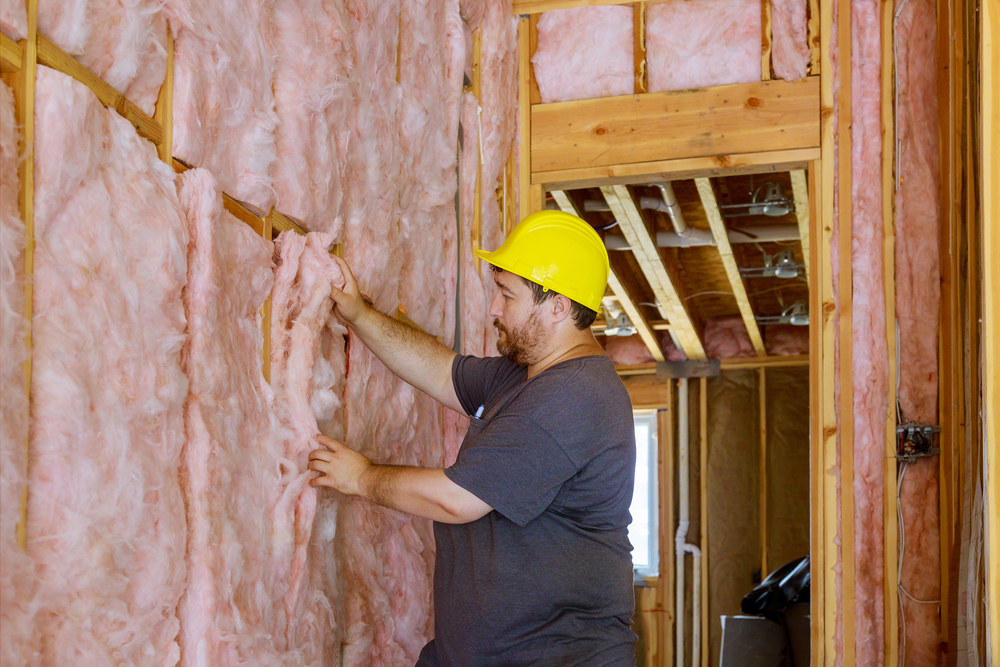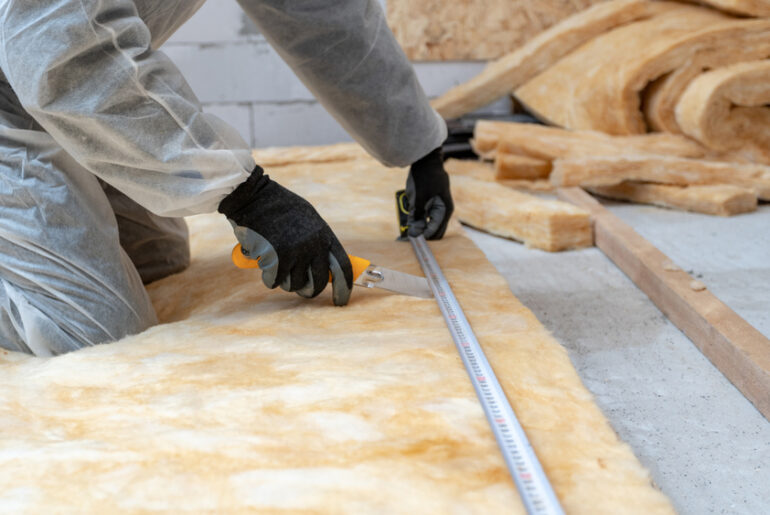Fiberglass insulation can safely touch ductwork without starting a fire. Fiberglass batt insulation is often found surrounding both metal and coil type ductwork to maintain the temperature of the air as it travels through the duct.
Here we will discuss how and why fiberglass insulation is used around ductwork and how to avoid common problems caused by poor installation.
Is it Safe For Fiberglass Insulation to Touch Ductwork?
Fiberglass insulation is safe to use around ductwork in either its blown or batt forms. Fiberglass insulation is literally made from tiny strands of glass, which have a high melting point.
Fiberglass will not burn, but it will melt. The vapor barrier on faced fiberglass batts can burn, but it is treated with fire retardants from the factory making the ignition point very high.
For the surface of the ductwork to become hot enough to melt the surrounding fiberglass or ignite the vapor barrier, the air inside would need to exceed 200 degrees fahrenheit.
Residential heating coils in common HVAC systems are incapable of providing this much heat, making fiberglass safe to use around ductwork.
How to Insulate With Fiberglass Behind Ductwork
Attics are a great place to insulate with fiberglass behind and around ductwork. Crawlspaces are also excellent examples. Heating, Ventilation, Air Conditioning, and Cooling, (HVAC) system installation can utilize any number of duct shapes and materials.
Here we will describe the most common fiberglass insulation types and how they are used around and behind ductwork:
Rigid Ductwork
Rigid ductwork is made from galvanized steel or aluminum because it is inexpensive and easy to work with. Tubular, rigid ductwork is usually insulated with R-6 to R-8 fiberglass roll insulation like this one.
If the rigid ductwork is square or rectangular, you can use roll insulation or rigid fiberglass insulation boards. Rigid insulation boards are made from fiberglass, so they are handy for insulating flat surfaces like four sided ductwork.
After the insulation is cut to fit, it is taped to the ductwork using special metallic duct tape. The tape is quite sharp, so gloves should be worn when installing it.
Professionals make neat folds in the corners and go over the tape with a pocket hair comb to completely seal the tape to the insulation.
Flexible Ductwork
Flexible ductwork is already insulated from the factory. Flexible ductwork is made from coiled steel wire, plastic, and fiberglass roll insulation. Most are insulated to R-6 or R-8 from the factory, but you can add blown or fiberglass batts on top to add R value.
Flexible ductwork usually comes in 25’ lengths and is extended like a spring. Aluminum collars are used to join two sections end to end when longer runs are required. Flexible ductwork is fast, inexpensive, and allows the duct to bend without the need for fittings.
Rigid Fiberglass Insulation Board
Rigid fiberglass insulation board can be used to build a trunk line or distribution point for the air flow. Rigid fiberglass insulation board is assembled with four flat sides and connected with HVAC duct tape.
Ducts built from rigid insulation boards are often assembled end to end to form a long section. The installer shaves a bit off the corners of one section, allowing it to slide into the next. The outer vapor barrier is then returned and taped with metallic duct tape.
Can You Put Fiberglass Insulation Around Heating Ducts?
You not only can, but should install fiberglass insulation around heating ducts. The purpose of duct insulation is to prevent the air traveling through it from changing temperature. In an HVAC system, the longer the run, the more insulation is needed to prevent this temperature loss.
Most HVAC systems use a central trunk line that directs the conditioned air coming from the unit and extends the length of the building. Smaller ducts are then split off to the individual zones or rooms.
As the air travels, it loses the heating or cooling because it mixes with the room temperature air already in the duct. This is why rooms furthest from the unit will often receive the least amount of conditioned air.
The insulation surrounding the duct helps prevent the air surrounding the duct from affecting the air inside the duct. Dampers are also used to redirect the air flow and volume to balance the system.
Most building codes require a minimum of R-8 around ductwork, but you can add more if necessary.
Can You Put Insulation On Top Of Ductwork?
You can install insulation on top of ductwork as long as you don’t add so much weight that you crush the ductwork. Insulation is lightweight by nature, so adding weight is not usually a concern. Some designs, like passive houses, commonly install insulation up to 36” thick.
Can Fiberglass Insulation Touch Heating Pipes?
Some homes are heated with gas pipes that transfer gas from the source to a furnace. Gas pipes are usually small diameter metal pipes painted black and are a common sight in crawlspaces.
The gas inside the pipe does not require insulation because no heat has yet been generated. The gas is not converted into heat until it reaches the furnace, so these pipes do not require insulation. If they come into contact with fiberglass insulation, it is perfectly safe.
Can Fiberglass Insulation Around HVAC Ductwork Grow Mold?
Fiberglass insulation can allow mold growth if constantly exposed to moisture. Fiberglass insulation works by trapping air between the tiny strands of glass. If fiberglass insulation (whether blown or batts) becomes wet, it must be allowed to dry.
When the air between the strands is displaced by water, the insulation becomes ineffective. Mold spores require constant moisture to thrive, so if the water cannot escape, the insulation becomes a breeding ground for mold.
Most fiberglass insulation (and cellulose as well) contain both a fire retardant and a moldicide. If installed properly, fiberglass insulation will not be affected by occasional moisture because the moisture will evaporate.
Add Insulation to Save Money
Adding insulation to your ductwork will result in energy savings, a more comfortable home, and a longer lifespan of your HVAC system. Use fiberglass insulation around ductwork to help keep your energy bills low and your comfortability high.





